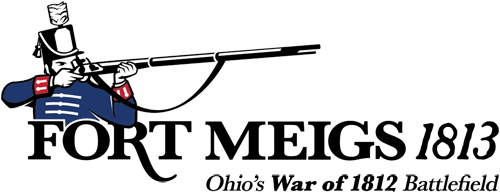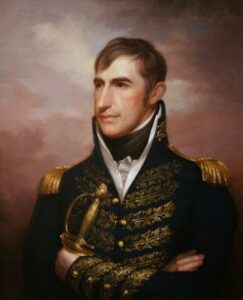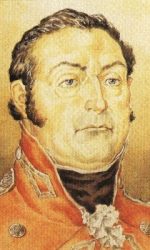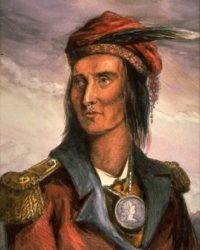Meet the People
WILLIAM HENRY HARRISON
General William Henry Harrison assumed command of the Army of the Northwest shortly after the surrender of General William Hull’s army at Detroit in 1812. Harrison’s army consisted of an assortment of U.S. Regulars and state militias, and was tasked with defending the American Northwest from further British advances. Harrison advanced his army to the Maumee River rapids in February 1813 and began construction of a ten-acre fortification which he named Fort Meigs in honor of Ohio’s governor Return Jonathan Meigs.General Harrison commanded the army that successfully turned back the British forces besieging Fort Meigs in May 1813. Harrison then turned over command of the fort to Brigadier General Green Clay of Kentucky. Harrison continued the defense of the Old Northwest culminating in his army defeating the British in October 1813 at the Battle of the Thames and ensuring the security of the Old Northwest.
Harrison left the army soon after the campaign ended. Shortly thereafter, he began his political career and was elected to the Ohio General Assembly. In 1840, Harrison was elected President of the United States of America. He died of pneumonia in 1841, one month after taking office.
HENRY PROCTOR
Henry Proctor assumed command of the British forces stationed around Fort Malden (Upper Canada) after General Isaac Brock died in October 1812 during the Battle of Queenston Heights. Proctor led the British forces during both sieges of Fort Meigs and the disastrous assault on Fort Stephenson in present day Fremont, Ohio. General Procter was forced to retreat from Fort Malden after the U.S. Naval victory on Lake Erie in September 1813. General William Henry Harrison invaded Upper Canada shortly thereafter and defeated Procter’s army at the Battle of the Thames in October 1813. General Henry Procter escaped capture following the defeat at the Battle of the Thames. Eventually, he was court-martialed for his role in the defeat and was suspended from his rank and pay for six months. He returned to England following the war where he died in 1822.TECUMSEH
Tecumseh, a Shawnee warrior and diplomat, was born in western Ohio in 1768. Some early accounts claim that he fought against George Rogers Clark in the American Revolution, Arthur St. Clair in 1791, and Anthony Wayne at Fallen Timbers in 1794.
In the early 1800s, Tecumseh attempted to unite the American Indian nations living west of the Appalachian Mountains into a confederacy that would oppose further Euro-American encroachment onto Indian lands. When the War of 1812 began, Tecumseh and many of these nations allied themselves with Britain.
Tecumseh led warriors during both sieges at Fort Meigs. It was his plan to create a sham battle during the second siege in an attempt to lure the American forces from the fort to destroy them and force the garrison’s surrender. The ruse failed and the British and Indian forces withdrew to attack Fort Stephenson, near present day Fremont, Ohio.
Tecumseh died in October 1813 fighting the Americans at the Battle of the Thames near present day Moraviantown, Ontario. Tecumseh’s death signaled the end of a united American Indian resistance against the United States of America.
ELEAZOR DARBY WOOD
Eleazor D. Wood was born in Lunenburg, Massachusetts in December, 1783. As a young man he studied medicine briefly at Albury, Vermont, but quickly chose a military career instead when he received an appointment to the recently created United States Military Academy at West Point. The academy was not yet a four year school so Wood spent a relatively short time there, entering May 17, 1805 and graduating on October 30, 1806. He was at once commissioned a second lieutenant in the engineers and was assigned to duty assisting in the construction of defenses on Governor’s Island in New York Harbor. He then spent the next several years in Virginia, where he advanced in both engineering skill and rank.
In November, 1812, Captain Wood was assigned to the Northwestern Army where he found himself doing the work of the chief engineer due to the illness of Captain Charles Gratiot, who officially held that post. His service in this post included overseeing the construction of Fort Meigs, some work on Fort Stephenson (at present day Fremont, Ohio), and assisting in the movement of Harrison’s army into Canada. On May 6, 1813, during the First Siege of Fort Meigs, he was brevetted major.
After participating in the Battle of the Thames, Wood was transferred to New York where he served with distinction in the Niagara area. For his conduct at the Battle of Niagara he was brevetted once more to the rank of lieutentant-colonel, in June, 1814. He was killed in action on September 17, 1814 during an assault on British forces besieging Fort Erie, opposite Buffalo, NY in Canada.1
Today, Fort Meigs stands in Wood County, Ohio, named in honor of E.D. Wood. The Statue of Liberty was placed inside the star-shaped Fort Wood, also named after him, on Bedloe’s Island (now Liberty Island) in New York Harbor.
1 Boehm, Robert B. and Randall L. Buchman, ed. Journal of the Northwestern Campaign of 1812-1813 under Major-General Wm. H. Harrison by Bvt. Lieut-Colonel Eleazor D. Wood. Defiance College Press, 1975, p.1.
"This day is cloudy and somewhat rainy, with heavy wind. Capt. Wood, one of our engineers, arrived here with five other persons from Lower Sandusky."
~ Captain Daniel Cushing
2nd Regiment, U.S. Artillery
April 2, 1813
Photo credit: Weaver



